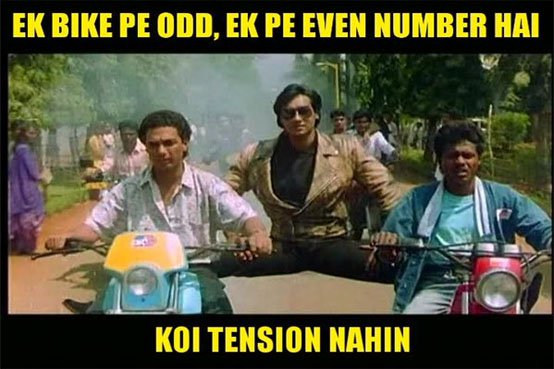The Delhi government’s announcement a few days ago, that cars with odd and even number plates will be allowed on Delhi roads on alternate days had predicable reactions ranging from muted appreciation to cynical dismissal. While some said this would be impossible to enforce such a law, others felt that Delhiites could find inventive ways to circumvent the order: another car or perhaps two number plates for the same car? After all Delhi citizens are not known for their law abiding nature or civic mindedness.
Your know what they say about good intentions and hell

(Image Source)
In addition to the 6,000 buses already on Delhi roads, an additional six thousand will be pressed into service. 50% of the 2,000 buses will have seats reserved for women. It is also proposed that each auto rickshaw will have two drivers so that its capacity in a given day can be doubled. A mobile app launching 25th December will also help commuters find the closest auto. The frequency of suburban trains is proposed to be increased. Also, vehicles obstructing bus paths will be heavily penalized.
But is it enforceable?

Even as netizens unleashed their opinions on the matter, many practical difficulties of this good faith move by the Delhi government materialized. In a city where it is impossible to fine speeding vehicles, lane and red light jumpers how on earth will an already over taxed police force check the number plate of every vehicle to check whether or not it should be on the road? And will not those Delhiites who can afford it, simply buy another car, thus nullifying the purpose of the exercise?
What about cars from out of town and from other NCR territories such as Ghaziabad, Noida and Gurgoan? Will Delhi drivers really mind shelling out a small amount in fines on the off chance that they will be caught; will the fine be any kind of deterrent? What of auto drivers who refuse to take passengers unless its at 300% higher charges? What of buses that don’t stay in their lanes and start obstructing private vehicles in their lanes? Most people would do anything rather than surrender themselves to the mercy of Delhi’s chaotic public transport systems. And what about genuine emergencies!
And what about the travails women face in public transport?
The idea is that more people should use public transport, but other than assigning some seats as being reserved for women, what changes have been made on the ground to make women safer? Women will still be subject to harassment in crowded buses and trains; they will still be subject to lewd comments and will still be unable to travel by public transport late at night or access lonely places on their own. In fact women, who are unable to use their own cars on alternate days will feel even more unsafe and insecure when forced to use public transport. We did hear something along the lines of women drivers and emergencies will be exempt, but there is still no clarity. All will be revealed on December 25 when the government releases the final set of rules.
Will it work, won’t it work, seems like the litany we intone as we pull petals off a hapless flower. The citizens and tax payers of Delhi begin the countdown to the new year with trepidation and mixed feelings.





